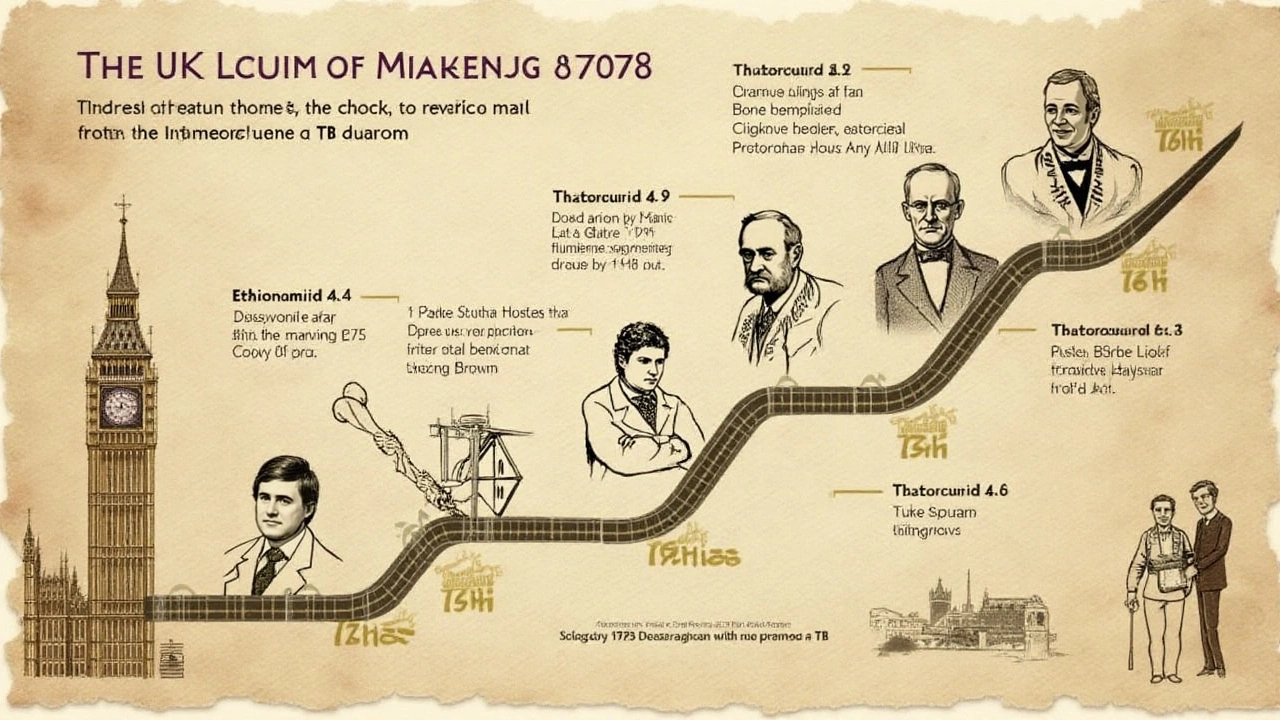Posted By Kieran Beauchamp On 23 Jan 2025 Comments (11)

Tuberculosis remains a formidable global health challenge, burdening millions and showing increasing resistance to traditional treatments. Ethionamide, a lesser-known but crucial drug, plays an essential role in combating this disease. As the threats of drug-resistant TB grow, re-examining the strengths and shortcomings of ethionamide becomes indispensable.
This article aims to shed light on the complex world of ethionamide, exploring its biological impact, the difficulties in its use, and the promising opportunities that lie ahead. By understanding these elements, researchers and healthcare providers can better strategize the use of ethionamide, paving the way for more effective TB treatments. Dive in to discover how this drug could potentially reshape our approach to tuberculosis, while addressing the pressing challenges that accompany its deployment.
Biochemical Mechanisms
Understanding the biochemical mechanisms of ethionamide is crucial for grasping how it fits into the broader picture of tuberculosis treatment. Ethionamide is a prodrug, meaning that it requires activation within the bacterial cell in order to exert its therapeutic effects. Once inside the mycobacterium, ethionamide undergoes a transformation. This is executed by the enzyme EthA, a monooxygenase that converts it into an active sulfide form. The presence of ethionamide in its active form disrupts the function of InhA, a target also affected by isoniazid, another anti-tubercular drug. This interruption prevents the synthesis of mycolic acids, essential components for the mycobacterial cell wall. Due to this action, ethionamide efficiently compromises the integrity of the bacterial defensive structures, leading to cell death.
Despite its effectiveness, ethionamide’s journey through the bacterial landscape is fraught with challenges. For one, the diverse genetic makeup of mycobacteria can influence the success rate of the drug. Variations in the EthA gene among different strains may lead to inconsistent drug activation, thereby affecting the overall therapeutic outcome. Interestingly, mutations in the mycobacterial genes that code for the transcriptional regulator EtaR have been linked to resistance against ethionamide, adding another layer of complexity to its use. However, it's not all bleak; elucidating these molecular interactions has opened avenues for optimizing its use. A precise understanding of these pathways not only aids in addressing the downsides but also highlights areas for innovation in drug design.
"Our ongoing research aims to demystify the enzymatic interactions of ethionamide, with hopes to enhance its efficacy against resilient TB strains," says Dr. Lina Ruiz, a leading researcher in antibiotic resistance.
Another aspect worth mentioning is the cofactor requirement for the activation of ethionamide. The enzymatic processes necessitate the presence of flavin adenine dinucleotide (FAD), which plays a significant role in the electron transfer necessary for activating ethionamide. This reliance implies that variations in the availability of FAD, or disruptions in its interaction with EthA, could impact the therapeutic efficiency. Scientists are particularly interested in discovering whether the manipulation of such cofactors could potentially boost the drug’s activity. These molecular considerations are vital as they shape our understanding and future strategies for overcoming resistance and tailoring treatment for diverse patient needs.
The biochemical landscape of ethionamide is both intricate and fascinating. As we learn more about its interaction with tuberculosis bacteria at the cellular level, one can’t help but envision the possibilities for enhanced treatments. Armed with this knowledge, researchers and clinicians can begin to conceive of new adjunct therapies that potentiate the impact of ethionamide, possibly in combination with other novel compounds that circumvent resistance. We stand at the cusp of a new era in tuberculosis treatment, with ethionamide offering a beacon of hope amidst growing challenges.

Current Challenges
In the sphere of tuberculosis treatment, the incorporation of Ethionamide has been a noteworthy advancement. However, its journey is fraught with challenges that continue to impede its broader application. One of the primary hurdles is the drug's side effects. Patients often report experiencing gastrointestinal disturbances, including nausea and loss of appetite, which can significantly affect adherence to the prescribed regimen. Furthermore, due to its mechanism of action, ethionamide can exacerbate hepatic conditions, necessitating regular liver function monitoring. These adverse effects not only complicate the treatment process but also limit the patient's willingness to comply with what can already be an arduous therapy timeline.
Resistance development is another critical challenge facing tuberculosis treatment with ethionamide. The bacterium responsible for tuberculosis, Mycobacterium tuberculosis, has demonstrated a worrying capacity to develop resistance, thus diminishing the efficacy of the drug. This resistance emergence is often due to genetic mutations within the bacteria, which can occur if patients default on their treatment or do not complete the prescribed course. Consequently, clinics and treatment centers are compelled to adopt more complex and costly intervention strategies, which can strain healthcare resources, especially in regions already burdened by limited medical infrastructure.
The availability and accessibility of Ethionamide also pose significant challenges. In low-income regions, where tuberculosis incidence is often high, the procurement and distribution of this medication can be a logistical nightmare. Informal pharmaceutical markets sometimes lead to the proliferation of counterfeit or substandard drugs, further hampering treatment efforts. Innovative distribution models, strong regulatory systems, and international cooperation are essential to address these obstacles. Importantly, improvements in healthcare infrastructure, coupled with education initiatives about the significance of fully adhering to treatment regimens, are crucial steps forward.
Moreover, clinicians face a dilemma when handling the socio-psychological dynamics of treatment. Ethionamide's lengthy administration, typically spanning several months, requires sustained commitment from patients already grappling with the physical and emotional toll of tuberculosis. The stigma associated with TB can lead to isolation at multiple social levels, possibly affecting patients' mental health and, by extension, their treatment engagement. It is imperative that healthcare systems provide holistic support, including mental health counseling and community-based programs, to foster a supportive environment that encourages treatment adherence.
"Navigating the challenges of multidrug-resistant tuberculosis requires a multifaceted approach. Ethionamide offers potential, but it must be coupled with rigorous oversight and patient education," says Dr. Maya Santos, a leading expert in infectious diseases.
A comprehensive approach involving researchers, clinicians, and policymakers is essential to overcoming these challenges. Investing in research for alternative formulations that might reduce side effects, as well as public health campaigns to raise awareness and support for those undergoing treatment, can make a significant difference. The future of ethionamide as a TB treatment hinges on addressing these hurdles effectively and efficiently, thereby ensuring that it remains a viable option for combating this persistent global health threat.

Opportunities for Innovation
Innovation within the realm of tuberculosis treatment particularly concerning ethionamide offers a myriad of exciting avenues. The world of medicine constantly evolves, and there is always room for improvement in how drugs are developed and employed. One promising area is the refinement of ethionamide's delivery systems. Researchers and pharmaceutical companies are exploring more efficient ways to administer ethionamide to enhance its absorption and effectiveness. One method involves the use of nanotechnology to create targeted delivery mechanisms, ensuring the drug reaches the precise area where it is needed most, thus minimizing side effects and maximizing impact.
Biochemists are also delving into the molecular structure of ethionamide to identify potential modifications that could lead to more potent derivatives. These derivatives could potentially offer higher efficacy against resistant strains of TB. Advances in genetic research provide another path, as understanding the genetic factors that lead to drug resistance in TB bacteria could help tailor ethionamide-based treatments to overcome these hurdles. The synergy between ethionamide and other anti-TB drugs is another focus area, with combination therapies showing promise in clinical trials. These combinations might reduce the total dosage of ethionamide required, thus decreasing the likelihood of side effects or toxicity.
"Harnessing the power of collaboration and open innovation can significantly accelerate breakthroughs in tuberculosis therapies," said a leading researcher at the Global Health Institute.
Moreover, there is a drive to make ethionamide more accessible to populations in low-resource settings. This could involve simplification of production methods or development of more stable formulations that do not require refrigeration. By achieving a stable and easily distributable form of ethionamide, healthcare systems in remote areas could integrate its use more seamlessly, heightening the global response against TB. Public health organizations are also championing wider educational campaigns that bring awareness to the benefits and potential of ethionamide, fostering a greater understanding among healthcare professionals on how best to incorporate it into their treatment regimens.
Data and technology are also key players in the future landscape of ethionamide's use. Artificial intelligence and data analytics are beginning to reveal patterns and insights from vast datasets, hinting at optimal treatment plans tailored by region or demographic. There is room for further exploration into how mobile health applications could support TB patients, reminding them to take ethionamide as prescribed and offering digital consulting to minimize the burden on healthcare facilities. The evolution of these technologies will likely broaden the horizon of what's possible for ethionamide in TB treatment.

Future Prospects
Looking ahead, the prospects of ethionamide in advancing tuberculosis treatment are both promising and complex. As researchers continue to dissect its biochemical properties, the drug offers a beacon of hope in the relentless fight against drug-resistant TB strains. While its use is not without challenges, current advancements in genetic research and molecular biology could lead to significant improvements in how ethionamide is administered and perceived within the medical community.
The potential transformation of ethionamide lies in optimizing its delivery and minimizing side effects. Investing in nanotechnology and precision medicine holds the potential to revolutionize how the drug interacts with cellular mechanisms, perhaps paving the way for higher efficacy and lower toxicity. By targeting the precise areas within the bacteria, such new methodologies can ensure that the drug maintains its potency while reducing the adverse effects typically associated with its use. Researchers are also exploring the synergistic effects when ethionamide is paired with other antimycobacterial agents, potentially unveiling new combination therapies that could prove to be more effective against resistant strains.
In a speech at the Global TB Summit, Dr. Amara Wilson, a leading figure in infectious disease research, stated,
"In an era where antibiotic resistance looms large, harnessing the full potential of drugs like ethionamide could be the lever we need to tip the scales in our favor."Such expert insights underscore the importance of integrating ethionamide with novel therapeutic strategies and the need for continued research to fully understand and address the intricacies of TB resistance.
Another promising avenue for enhancement of ethionamide's impact is by leveraging big data and AI technologies. These tools can analyze vast datasets to uncover patterns and predict outcomes faster than traditional methods, offering insights into personalized treatment plans that could significantly enhance patient outcomes. With AI-driven modeling, potential mutations in TB strains that may incur resistance to ethionamide can be forecasted, enabling researchers to tailor interventions swiftly.
Moreover, the democratization of ethionamide hinges on global policy support and health infrastructure improvements, ensuring that developing regions most affected by TB have adequate access. Enhanced international cooperation, spurred by organizations like the WHO and national health bodies, can potentially make a marked difference, streamlining the pathways to widespread availability and affordability. With the dramatic increase in TB cases worldwide, especially the multidrug-resistant types, making ethionamide accessible to all is not just a matter of scientific progress but a global health imperative.

Chris Rowe
January 24, 2025 AT 05:45ethionamide? more like ethio-nope. why are we still talking about this 1960s relic like it’s the cure-all? my cousin took it for 8 months and still got TB again. the side effects were worse than the disease. 🤮
Sushmita S
January 25, 2025 AT 02:01lol i just googled this and saw ‘ethionamide and alcohol’… so wait, you can’t even drink tea while on this? 😭
AnneMarie Carroll
January 26, 2025 AT 10:00Oh please. You’re all acting like ethionamide is some miracle drug. It’s a last-resort poison with a 40% failure rate in resistant strains. The WHO should’ve buried this decades ago. If you think nanotech or AI will fix a drug this fundamentally flawed, you’re delusional. 🤦♀️
John K
January 26, 2025 AT 10:28USA makes better drugs. This is why other countries are falling behind. We got real science here. Not this third-world junk. 💪🇺🇸
Laura Anderson
January 27, 2025 AT 14:27There’s a metaphysical dimension to ethionamide’s failure that transcends biochemistry. The drug doesn’t just attack mycobacteria-it attacks the soul’s resilience. When patients experience nausea, it’s not just a side effect-it’s the body’s existential protest against a system that offers toxicity as salvation. We must ask: Is healing possible when the cure is a violation?
And yet, we persist. Why? Because we’ve confused compliance with compassion. Because we’ve turned medicine into a bureaucratic ritual. Because we’ve forgotten that a pill cannot cure isolation. The real resistance isn’t in the bacterial genome-it’s in our refusal to treat the patient as a whole being.
Perhaps ethionamide isn’t the problem. Perhaps we are.
Avis Gilmer-McAlexander
January 28, 2025 AT 06:31Okay but what if we just… stopped treating TB like a war and started treating it like a community project? Like, imagine if instead of just dumping pills on people, we had local healers, peer support groups, and free meals during treatment? I’ve seen programs in rural India where they use dance and storytelling to help people stick to meds-no nanotech needed. Ethionamide’s not the hero. People are. 🌱
Jerry Erot
January 30, 2025 AT 00:34Interesting. Very interesting. I’ve read three papers on EthA mutations and FAD dependency. The real bottleneck isn’t the drug-it’s the lack of standardized genotyping in low-resource settings. If we could map mutations in real time with portable sequencers, we could predict resistance before treatment even begins. But no one wants to fund that. Too expensive. Too… inconvenient.
Fay naf
January 31, 2025 AT 19:35Let’s be brutally honest-the entire ethionamide paradigm is a failure of pharmaceutical innovation. We’re clinging to a prodrug from the Cold War because Big Pharma doesn’t want to invest in novel scaffolds. The FAD dependency? A design flaw. The hepatotoxicity? A liability. The resistance mechanisms? Predictable. This isn’t science-it’s pharmaceutical malpractice dressed up as ‘hope’.
And don’t even get me started on the ‘AI-driven personalized regimens’ nonsense. You can’t algorithm your way out of systemic neglect. The patients aren’t data points. They’re dying because we chose convenience over courage.
ANTHONY SANCHEZ RAMOS
February 1, 2025 AT 08:45yo i work in a clinic in texas and we just started using ethionamide with a daily text reminder system + free breakfasts for patients. guess what? adherence jumped 60%. no magic. just care. 🙌 maybe we don’t need nano-bullets… just human connection. also i typo a lot sry 😅
Matt Czyzewski
February 2, 2025 AT 12:50One cannot speak of ethionamide without invoking the dialectic of suffering and salvation. The molecule itself is a paradox: a weapon forged in the crucible of desperation, yet capable of both destruction and redemption. In its activation by EthA, we see the fragility of biological order-where a single enzymatic misfire can unravel the promise of life. Is it not then, the most humble of medicines? Not because it is weak, but because it demands humility from those who wield it.
And yet, we treat it like a commodity. Like a checkbox on a protocol. We forget: the mycobacterium does not fear the pill. It fears the absence of continuity. The absence of care. The absence of being seen.
Chris Rowe
February 4, 2025 AT 10:16^^^ this guy just turned a TB drug into a Shakespeare soliloquy. chill. it’s a pill. not a poem. also i still hate it.